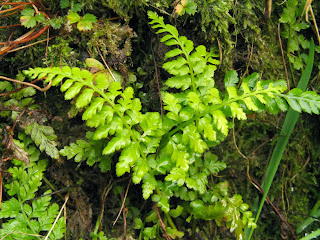A couple of weeks ago, a circular walk from Tonyrefail in the late afternoon gloom took me past a bank on which was growing an odd-looking fern, with the overall appearance of a small Lady Fern (Athyrium filix-femina) but with the more leathery leaves and linear sori (groups of spore-cases) characteristic of the spleenworts (Asplenium spp.). A return visit and closer inspection confirmed my initial suspicions, that this was the county rarity Lanceolate Spleenwort (Asplenium obovatum).
 |
| Fresh fronds of Asplenium obovatum at Tonyrefail - this was one of the larger plants. |
The plants were growing on a lightly-vegetated south-facing retaining bank, with plenty of exposed stone. I'm familiar with this species from West Devon, where it is local in exactly the same habitat. The Tonyrefail population seems to be quite healthy, with over 40 plants of various sizes.
 |
| The retaining stone wall on which Asplenium obovatum was growing - the pale-green fronds caught my eye. |
Asplenium obovatum has only ever been known from four sites in Glamorgan. Of these, only two seem to be extant - one at Penmaen in the Gower and another localised only to ST19M (jointly Glamorgan & Monmouthshire)... so it was a nice botanical 'Christmas present' to add another site to this list!


Congratulations on this excellent find; I'll keep my eye out for that one. I find winter is also a good time for finding club mosses here in the uplands. They seem to stand out more against the surrounding vegetation.
ReplyDelete